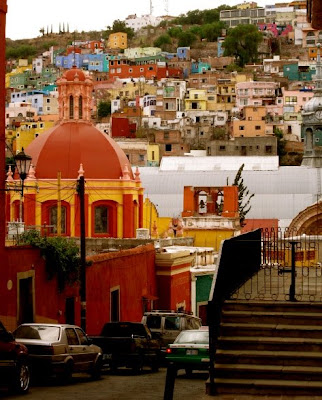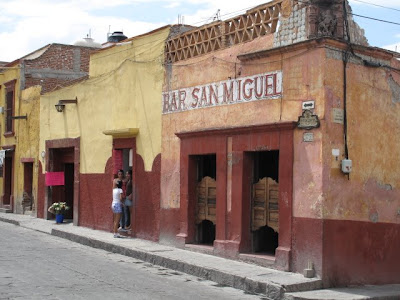






Guanajauto, Guanajauto State, 7 - 10 May, 2009
We bade farewell to the beautiful environs of Villa Patzcuaro and our new friend Latifa to hit the road again. Rather than take the boring cuota highway back to Morelia, we followed the secondary road north along Lake Patzcuaro through the Tarasco Indian towns of Tzintzuntzan (which onomatopoeic name means "Place of the Hummingbirds", and is also centre of the Tarasco nation) and Quiroga (named after the liberal Conquest-era bishop who is still revered for his good works and understanding of native culture). Were we ever glad we did! Tzintzuntzan is the center of cantera stone sculpture, and we drove literally through one "showroom" where both sides of the road were lined with sculptures in the reddish rock of every description. We picked up some very cheap pottery in the square (four pieces for 6 bucks!). The town is very neat and well-kept and still retains some pre-Hispanic ruins. Quiroga was more boring, like any other town in Mexico.
We paid a lot of cuota tolls and passed through a lot of less-inspiring terrain from Morelia through to Guanjuato, our next destination. It is a town steeped in history, from the beginnings of Spanish imperialism through the War of Independence and the Revolution. It started as a silver mining town, and like the design of a warship, primary consideration was given to its main purpose and only after was thought given to where the people should go. In this case, that was up on the surrounding hillsides. We somehow made it to our campsite on the first try, despite the confusing directions given in the camping guide book, and had to finish the trip by driving the wrong way down a precipitously steep one-way street. We weren't completely sure that it was still operating as a campground until Lupa, the caretaker, came out to unlock the rotted wooden doors to the washrooms. We managed to make ourselves a cozy little nook with a killer view over town, once some garbage and doggy-do was cleaned up.
The trip into town always started with a walk down the incredibly steep, cobble stoned streets to a traffic circle ("glorieta" or "rose", in Spanish). There we would wait until a cab came along to take us down town. The route usually involved taking one or more of the tunnels, taking us quickly from one part of town to another in a city that would otherwise be divided by the steep slopes upon which it is built. They are old mining tunnels that have been enlarged and reinforced, and the complex is so vast that there are underground intersections patrolled by Transito police. The tunnels are said to be haunted, and sometimes you can hear a woman's moans.
Speaking of being haunted, this is one town full of ghosts. The Spanish used African slaves in the mines, because the local Indians apparently weren't hardy enough to withstand the rigors of the work. The leaders of the Independence movement, when finally captured and executed by imperial forces, had their heads displayed in cages on a building downtown. We visited a wax museum, which was set up with images of the decapitated leaders and had a few displays and figurines that really freaked the boys out.
Of course, this was all a good set-up for when we went the following day to see the Guanajuato Mummy Museum. This is a display of corpses that have been removed from crypts in the local cemetery where a particular combination of dessication and minerals in the ground have preserved the skin of people buried there. The mummies are of people who no longer have families present, willing or able to continue paying for the upkeep of their crypts, so they have been evicted from what was supposed to be their final resting place. It is rather gruesome, to see them now the objects of this entrepreneurial enterprise.
Not that considerations of preserving the dignity of the dead kept us from paying the admission fee and going in to gawk like everyone else. It was sad to see the infant corpses, dressed as saints and angels as is the custom here, or the mother and child, both having died in childbirth, buried together. The whole thing is justified as a means of preventing the defilement of the bodies, which at one time were stacked like cordwood in a large, open room, and sightseers would remove pieces as souvenirs. It was a voyeuristic experience, with the attendant slightly dirty feeling afterward. The souvenir stalls outside the museum even sold taffy molded to look like mummified bodies. For days afterward, Remy kept picturing people on the streets as mummies- a real reminder of our mortality.
The days were long, spent exploring the town and eating. It is hard to keep one's bearings, as the streets wind every direction. We celebrated Mother's day early, sending Liz for a much-needed back massage and buying some fresh flowers for the van. We found our favourite coffee shop, Conquistador Coffee, and toured the Diego Rivera museum (buck fifty admission). There are some very cool restaurants- La Fonda Antigua, where the woman who runs it was so sorry we had arrived too late to eat gave us free papaya agua de fruta and promised to cook us the same thing the next day; and Ocho,a three story restaurant/bar, where we ate outside on the plaza.
On the final day in Guanajuato we took a bus to San Miguel de Allende. We felt we had to see it, though there wasn't anything in particular compelling us to go. We took the second class bus there- big mistake! We arrived hot, cramped, and late, having made every milk-run stop possible. We bumped around town and saw the great, 4-block long artisan's market. The town, while beautifully well-kept, lacked some of the spirit that we expect and look forward to in Mexican towns- it was a little bit boring. Not to mention expensive, and the cabbie from the bus terminal ripped us off. The first-class bus trip back, with drinks, snacks, a movie, a toilet and leg room was much better for very little extra money (29 bucks for the four of us in 1st class versus 20 for 2nd), and dinner at the above-mentioned restaurant/bar cheered us up.
Hollis had obsessed about a plastic action figure he had seen in a shop. The asking price, 44 dollars, made everyone else, including Bowen, cringe. Hollis insisted, though, and against the counsel of the rest of his family, purchased it with his own money. He impressed us with how little he allowed himself to be influenced by the opinions of others.
-Remy



No comments:
Post a Comment